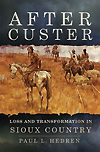
After Custer: Loss and Transformation in Sioux Country, by Paul L. Hedren, University of Oklahoma Press, Norman, 2011, $24.95
Historians have analyzed the life of Lieutenant Colonel George Custer and the Battle of the Little Bighorn probably daily since the disaster for the 7th Cavalry back in June 1876. But Paul L. Hedren, a retired National Park Service superintendent, takes a different tack in his new book, studying what happened after the battle.
Immediately after the West’s most famous clash between soldiers and Indians, the soldiers ramped up their pursuit of the hostile Plains Indians. The Army won the Great Sioux War (1876–77) in the end, but at no small cost—with 16 officers and 275 enlisted men, scouts and packers killed. Another 140 individuals were wounded. On the Indian side, Hedren estimates that 162 were killed and 236 wounded. Of course, the cultural devastation was enormous.
“The Great Sioux War in and of itself brought irreversible change to the northern Plains,” Hedren writes. “Foremost, the Sioux Country of old no longer existed, except in a largely imaginary and emotional sense. And the war indeed provided unfettered access to an irresistible and undeniably valuable quarter of the American West.” Sitting Bull, the Lakota spiritual leader at the Little Bighorn, led a band to exile in Canada, but in 1881 he, too, surrendered to the Army. “Sitting Bull’s return from Canada,” Hedren writes, “marked the last of the unfinished business directly related to the Great Sioux War, which ended one way of life for the Lakotas and set the course for another. But the legacy of that war would trail through the decades to come.” He tackles the coming of the Northern Pacific Railroad and, in turn, the booming of the cattle industry in a country where buffalo and Indians once abounded.
Hedren’s account of the transformation of what once was Sioux country is evenly handled while moving and thought provoking. It’s the perfect postscript to those countless books about the Boy General’s glorious defeat and the Lakota people’s triumph and tragedy.
—Johnny D. Boggs




